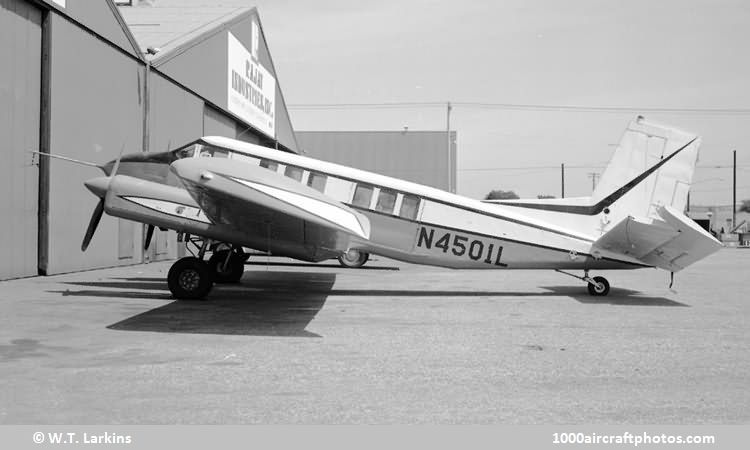Design of the prototype started in 1962 and construction began in the following year. First flight was made in June 1964 and the first production aircraft flew in January 1969, with FAA certification being granted on July 21, 1970. It was intended to obtain certification for operation on floats or skis, but in event was not pursued. A turbocharged version, which had an increased max take off weight of 5,700 lb (2,585 kg), was awarded a Supplemental Type Certificate on March 8, 1973 and was known as the 4500-300-II.
Seven production aircraft had been completed by January 1974, and demand for the aircraft was such that Evangel planned to increase production to three aircraft per month by November 1974, however, no further aircraft were produced.The pictured prototype was eventually modified to the turbocharged Model 4500-300-II and is still registered to a private owner in Alaska. The following data relate to the Model 4500-300."
Type: Nine-seat light passenger/cargo aircraft.
Wings: Cantilever low-wing monoplane. Dihedral on outer panels 9° 30'. Incidence 3° 15'. Conventional all-metal light alloy structure. Cambered wing tips. Frise-type light alloy ailerons. Single-slotted trailing edge flaps of light alloy construction. Ground-adjustable trim tabs on ailerons.
Fuselage: Rectangular-section all-metal structure.
Tail unit: Cantilever all-metal structure. Large dorsal fin faired into upper surface of fuselage. Dihedral on tail plane. Horn-balanced elevators. Controllable trim tabs in rudder and elevators.
Landing gear: Tail wheel type, main units only retracting rearward into undersurface of wings. Hydraulic retraction. hand pump for emergency retraction or extension. Allied Machinist oleo-pneumatic shock-absorbers on main units. Goodyear main wheels and tires size 24 x 7.7, pressure 40 lb/sq.in (2,81 kg/sq.cm). Castoring tail wheel with Cleveland wheel and tire size 40-77, pressure 35 lb/sq.in (2.46 kg/sq.cm). Goodyear hydraulic brakes.
Power plant: Two 300 hp Lycoming IO-540-K1B5 six-cylinder horizontally-opposed air-cooled fuel injection engines, each driving a Hartzell two-blade constant-speed fully-feathering metal propeller with spinner. Alternatively, a version designated 4500-300-II with Rajay turbochargers was available. Two integral wing fuel tanks, total capacity 111 gal (420 l). Refueling points in upper surface of wings. Oil capacity 6 gal (23 l).
Accommodation: Pilot and eight passengers in enclosed cabin. In initial layout two passengers accommodated on forward-facing seats, remaining passengers seated on inward-facing seats. Cockpit doors on each side of fuselage, hinged at forward edge. Large cabin doors, one on each side of fuselage, at rear of cabin, hinged at forward edge. Cockpit and cabin heated and ventilated.
Systems: Hydraulic system, for operation of flaps and main landing gear, supplied by electrically-driven hydraulic pump. Electrical system powered by 12V 50A engine-driven generators.
Electronics and equipment: Full IFR instrumentation standard. Narco and King nav/com radios to customer's requirements.
Wing span: 41 ft 3 in (12.52 m)
Wing chord, constant: 6 ft 0 in (1.83 m)
Wing aspect ratio: 6.83
Length overall: 31 ft 6 in (9.60 m)
Height overall: 9 ft 6 in (2.90 m)
Tail plane span: 14 ft 61 in (4.43 m)
Wheel track: 11 ft 2 in (3.40 m)
Wheel base: 20 ft 4 in (6.20 m)
Propeller diameter: 6 ft 8 in (2.03 m)
Propeller ground clearance: 10 in (0.25 m)
Cockpit doors (forward):
Height: 2 ft 81 in (0.82 m)
Width: 1 ft 9 in (0.53 m)
Height to sill: 4 ft 9 in (1.45 m)
Cabin doors (aft):
Height: 2 ft 11 in (0.89 m)
Width: 3 ft 9 in (1.14 m)
Height to sill: 2 ft 0 in (0.61 m)
Cabin, excluding flight deck:
Length: 10 ft 0 in (3.05 m)
Max width: 3 ft 8 in (1.12 m)
Max height: 3 ft 8 in (1.12 m)
Floor area: 36.7 sq.ft (3.41 sq.m)
Volume: 135 cu.ft (3.82 cu.m)
Wings, gross: 251 sq.ft (23.32 sq.m)
Ailerons (total): 32.0 sq.ft (2.97 sq.m)
Trailing edge flaps (total) 28.4 sq.ft (2.64 sq.m)
Fin: 31.5 sq.ft (2.93 sq.m)
Rudder, including tab: 34.2 sq.ft (3.18 sq.m)
Tail plane: 62.0 sq.ft (5.76 sq.m)
Elevators: 27.5 sq.ft (2.55 sq.m)
Weight empty: 3,530 lb (1,601 kg)
Max take off and landing weight: 5,500 lb (2,495 kg)
Max zero-fuel weight: 4,834 lb (2,192 kg)
Max wing loading: 21.9 lb/sq.ft (107 kg/sq.m)
Max power loading: 9.17 lb/hp (4.16 kg/hp)
Performance (at max take off weight).
Max never-exceed speed: 230 mph; 370 kmh
Max cruise, 75% power at 6,000 ft (1,830 m): 182 mph (293 kmh)
Econ cruise, 65% power at 10,000 ft (3,050 m): 175 mph (282 kmh)
Long-range cruise, 55% power at 14,000 ft (4,275 m): 171 mph (275 kmh)
Stall speed, flaps down: 67 mph (108 kmh)
Max climb at sealevel: 1,500 ft (457 m)/min
Max climb at sealevel, one engine out: 225 ft (69 m)/min
Service ceiling: 21,030 ft (6,410 m)
Service ceiling, one engine out: 6,200 ft (1,890 m)
Min ground turning radius: 11 ft 0 in (3.35 m)
Take off run: 500 ft (152 m)
Take off to 50 ft (15 m): 1,125 ft (343 m)
Landing from 50 ft (15 m): 1,140 ft (347 m)
Landing run: 475 ft (145 m)
Range with max fuel:
75% power at 6,000 ft (1,830 m): 637 mls (1,025 km)
65% power at 10,000 ft (3,050 m): 700 mls (1,126 km)
55% power at 14,000 ft (4,275 m): 750 mls (1,207 km)
